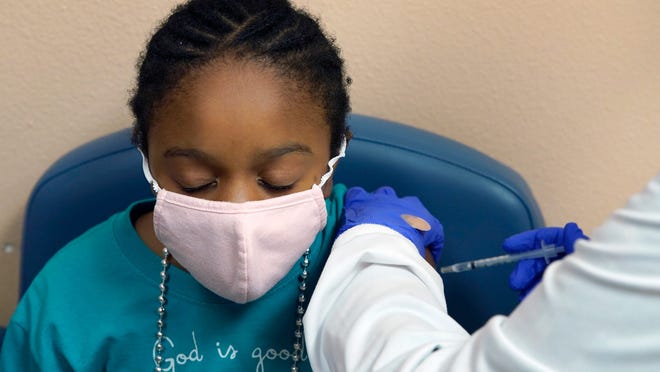When the U.S. surpassed 1 million COVID deaths Tuesday, the somber milestone provided yet another reminder of the enormous human toll extracted by a pandemic the nation is eager to leave behind.
At a time when Americans have largely ditched masks and may be more preoccupied with inflation, abortion laws and the war in Ukraine, it’s easy to forget the coronavirus has claimed more lives in this country than its deadliest conflict – an estimated 750,000 died in the Civil War – or previous outbreak. The 1918 flu pandemic killed about 675,000 people domestically.
A current resurgence serves as proof of the virus’ lingering presence, and the White House recently warned the fall and winter could bring as many as 100 million new infections.
On Thursday, as the U.S. closed within 1,000 deaths of the inevitable landmark, President Joe Biden ordered flags in public buildings flown at half-staff and issued a statement saying:
“As a nation, we must not grow numb to such sorrow. To heal, we must remember. We must remain vigilant against this pandemic and do everything we can to save as many lives as possible.”
Here are some pertinent facts about COVID:
How many people have died from COVID worldwide?
There’s no official figure. The Johns Hopkins University dashboard, used by USA TODAY and other news organizations, puts the total at close to 6.3 million. A study released in early May by the World Health Organization estimates closer to 15 million global deaths.
For several reasons, including political concerns, an accurate number will probably never be established. Based on the Johns Hopkins count, the U.S. is the first nation with as many as 1 million deaths, but the WHO analysis estimates there were 3.3 million to 6.5 million uncounted deaths in India, a figure the country disputes.
When was the first COVID death in the US?
For more than a year it was believed the first victim was Patricia Dowd of San Jose, California, who died Feb. 6, 2020, almost three weeks earlier than three fatalities in Washington state originally considered the first in the country. But the Mercury News in San Jose reported in August 2021 about six COVID-related deaths in six different states that took place in January 2020.
The CDC’s National Center for Health Statistics now lists six fatalities that month with COVID as a contributing factor – one as early as Jan. 11– but the identities of the deceased have not been revealed. With so much about COVID, the actual first death may remain a mystery.
The most affected by COVID?
Without a doubt, seniors have borne the brunt of the coronavirus’ impact in the U.S. Nearly three-quarters of the 1 million deaths – 741,000 – have been among those 65 and older, according to an analysis of national data conducted by The Associated Press. The study also showed more men than women have been killed by COVID in almost all age groups, and that when adjusting for age, Black, Hispanic, Pacific Islander and Native American people have died of the disease at disproportionate rates.
How many children have died of COVID?
Kids respond considerably better than adults to coronavirus infections, which helps explain their low number of fatalities even though millions of them were not eligible for vaccination before May 2021 (ages 12-15 at that time, 5-11 in early November).
According to the CDC, which has age data for about 850,000 COVID deaths, 1,532 minors have died of the disease in this country, 484 of them under age 5. A vaccine for children in that age group still hasn’t been authorized.
The big regret: Unvaccinated bear the brunt
About 400,000 Americans have died of COVID since mid-June 2021, a time when vaccines were widely available throughout the country. More than 300,000 of those have been unvaccinated.
“The way my mother passed away and how she suffered at the end and was so scared, I wouldn’t wish that on my worst enemy,’’ said Julie Anastas of Kingston, New Hampshire, whose unvaccinated mother died of COVID in December.
READ IT HERE:‘A terrible price’: As US mourns 1 million COVID-19 deaths, preventable losses among unvaccinated a major regret
A pandemic legacy of grief, anger
Over the past two years, the victims of COVID-19 were like fallen raindrops, one, then another, and another, and another – a river of death. There is no way to fully comprehend the toll of the past two years without looking closer at some of the losses.
Everybody will process the enormity of the death count differently based on their personal experiences and beliefs. But all are victims.
READ IT HERE:A pandemic legacy of grief, anger and frustration
A portrait of inequity
The COVID death rate of nearly 1 in 100 in Hancock County, Georgia, ranks as the fourth highest in the nation, 3 1/2 times the nation’s rate. Whole families have died of the disease in the predominantly Black county of 8,600 residents, a quarter of whom are 65 or older. Seniors and disadvantaged minorities have endured a huge share of the coronavirus’ worst impacts.
“Funerals sometimes twice a day,” Pastor Lillie Tripp said. “I’ve done that ever since COVID came in. It wears on your spirit.”
READ IT HERE:‘It wears on your spirit’: A hard-hit Georgia county reckons with loss
Live your life, but remain cautious
As someone who regularly sees very sick patients come into the hospital with COVID, Dr. Thomas K. Lew – a member of USA TODAY’s Board of Contributors – knows the coronavirus has not disappeared. He also recognizes people can’t live in constant fear of getting infected.
What to do? Take a middle-of-the-road approach: Be vaccinated (and boosted or double boosted if eligible), mask if in high transmission areas – including crowded indoor settings or public transportation – and test often, he said.
READ IT HERE:1 million COVID deaths is an enormous number, something I never thought possible


